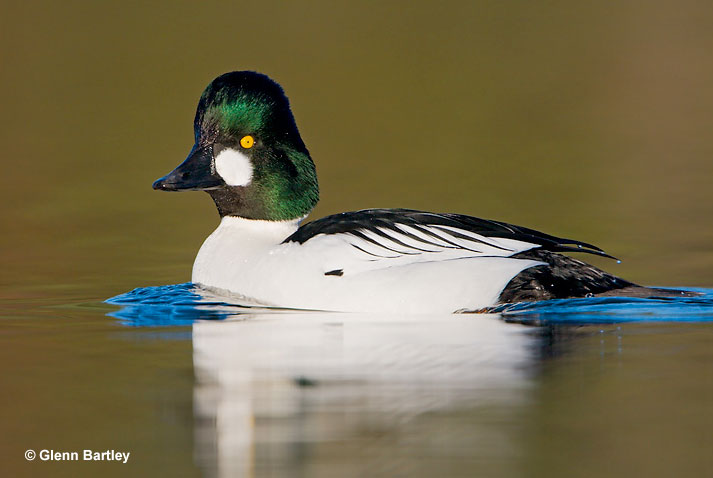Common Goldeneyes (Bucephala clangula) are striking diving ducks. Males are characterized by black-and-white plumage, distinctive yellow eyes, and an iridescent green head, whereas females are gray with a brown head.
They are cavity nesters, and their young may jump from great heights to follow their mother. Here is some extra information to satisfy your curiosity!
Identification
Common Goldeyes are medium-sized, measuring 16-20 inches long with a wingspan of 30-33 inches. Both the male and female have golden yellow eyes, hence the name. They have rather small, triangular bills that make it look like their heads are triangular as well.
Male
Male Common Goldeneyes are stunning. They have a black triangular head with green iridescence and a white spot behind the bill. The bill itself is small, triangular, and black. They have white bodies and black backs. Their wings are black with a big white patch visible when they’re flying and with white windows when they’re folded.
Immature males have a black head and black back but mottled white and dark gray bodies instead of white ones. They are duller overall and lack the green iridescence on their heads.
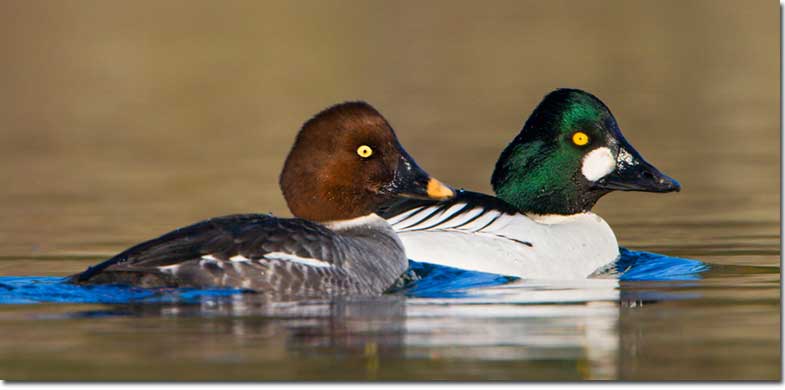
As with most bird species, males have distinctive plumage, while females look like duller versions of their male counterparts.
Female
Female Common Goldeneyes are stunning in their own way. They have slightly mottled but overall gray bodies, a white ring around their neck, and warm brown heads. Their bills are also small and triangular but are black with a yellow tip. Their wings are blackish and have a white patch on the inner half.
Juvenile Common Goldeneyes are mostly dark brown all over. They lack any specific markings, they have blackish bills, and dark brown eyes.
Vocalizations
Common Goldeneyes have several calls but are mostly silent, except during the breeding season or when disturbed. Males give short and faint peent calls and grunt.
Females may make cuk sounds while flying and give harsh gack sounds when disturbed. If they’re in flight, their wings make a whistling sound.
Food
The diet of Common Goldeneyes varies depending on the season and habitat. They mainly feed on animal matter, which makes up about 70% of their diet, with the rest being plant matter, such as seeds of various aquatic plants, including pondweeds and bulrush.
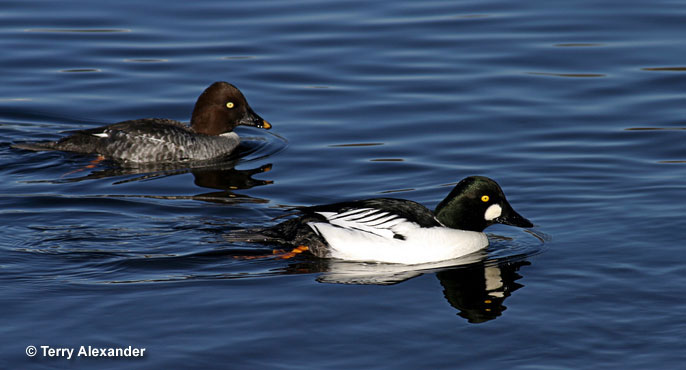
Their most common foods include aquatic invertebrates, such as insects, mollusks, and crustaceans. Some of their favorite prey items include caddisfly larvae, dragonfly and damselfly nymphs, beetles, water boatmen, crabs, barnacles, mussels, shrimp, crayfish, and amphipods. You may also see them munch on small fish, such as sticklebacks and minnows, or fish eggs.
Common Goldeneyes are proficient divers and generally dive to find food. They can forage in fairly deep waters, up to 20 feet or even deeper in some cases. However, they prefer shallower waters that are less than 13 feet deep.
Read more: What do ducks eat?
While they primarily forage underwater, Common Goldeneyes may also feed at the water’s surface. They may pick insects and other floating items from the water’s surface or up-end.
Nesting and Eggs
Common Goldeneyes start pairing up in December with the bond lasting through the breeding season until the beginning of incubation. It is unknown whether they reunite with their mates for the next season.
Courtship is done in groups of several males and females. Males bob their heads and then throw their heads to their rump and emit shrill calls. Females respond by lowering their heads and swinging them forward.
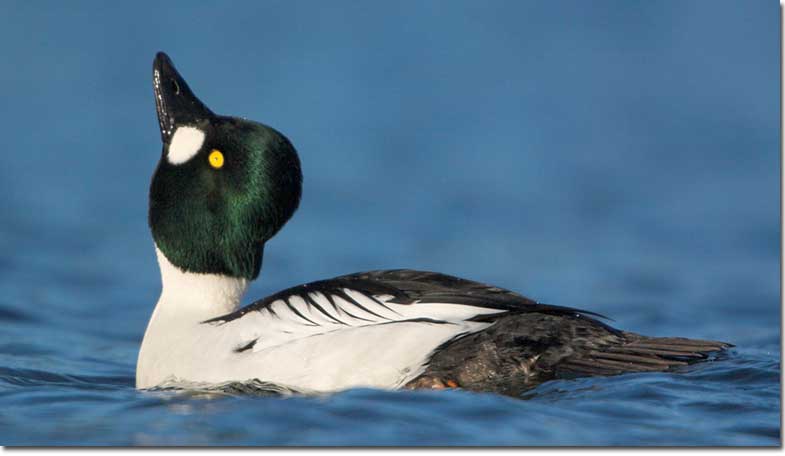
The act of courtship
Common Goldeneyes are cavity-nesting ducks, and the choice of nesting site can vary based on availability and environmental conditions.
They typically nest in tree cavities 5-60 feet above the ground but can also opt for nest boxes and, on rarer occasions, rock crevices or abandoned buildings.
The mother forms a nest bowl from materials that are already in the cavity, which can include wood chips and other debris, and then lines it with her down feathers.
She then lays 4-17, mostly 8-11 olive-green to blue-green eggs. Common Goldeneye eggs measure 2.3-2.4 inches long and 1.3-1.9 inches wide. The mother bird incubates them for 27-33 days.
If she needs to leave the nest, she covers the eggs with her down feathers. Younglings leave the nest 1-2 after hatching and follow their mother to the water. They need to forage their own food while the female broods them at night and watches over them. The offspring fledge at around 8-9 weeks old, but the female abandons them a few weeks before that.
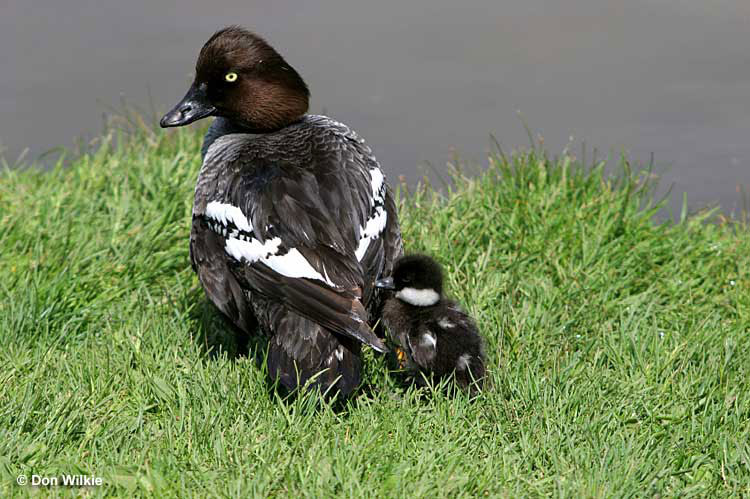
Current Situation
Common Goldeneyes range throughout most of North America, Scandinavia, the Baltics, and northern Russia.
In North America, they breed in Canada and mostly winter in the United States with some of their wintering range bleeding into Mexico. There are resident populations where their wintering and breeding ranges overlap, overall along the border of the US and Canada.
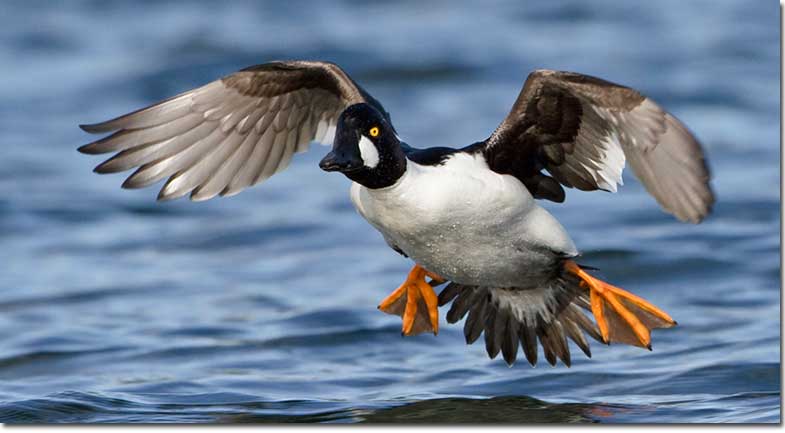
Common Goldeneyes’ habitats include various aquatic biomes but vary slightly depending on the season. During the breeding season, they are commonly found on lakes and rivers with little emergent vegetation that are surrounded by mature forests since they need large trees with cavities for nesting.
Come winter and the non-breeding season, they migrate to coastal marine and estuarine habitats but can also be found on large interior lakes and rivers. They prefer bodies of water that have sandy, gravelly, or rocky bottoms and are fairly shallow.
Common Goldeneyes are listed as of least concern on the IUCN Red List, and their population remains stable. However, they face various threats, such as habitat degradation, pollution, and modern forest management. The latter removes old trees that likely have suitable nesting cavities.
Facts
- Common Goldeneyes often lay their eggs in nests of other females and females of other species. This makes it slightly more complicated to correctly estimate clutch sizes and the reproduction of the species overall.
- Common Goldeneyes lay their eggs in tree cavities which can be as high up as 60 feet. So how do the ducklings get down if they leave the nest only a few days after hatching? In short, they jump! The female waits for them at the base of the tree and calls for them and then the ducklings take the leap of faith.
- Females generally abandon their offspring a couple of weeks before they fledge and gain the ability to fly. However, sometimes they do so only a week or two after hatching, which leaves the ducklings in a very vulnerable situation. If they’re lucky, they get to join another female’s brood.
- Common Goldeneyes generally live to be about 11-12 years old in the wild. The oldest wild specimen, however, lived about double that and was at least 20 years and 5 months old at the time of its death!
Similar Species
There are two other waterfowl that look similar to Common Goldeneyes: Barrow’s Goldeneye and Bufflehead. Here is some more information about them and how to tell them apart.
Barrow’s Goldeneye

Barrow’s Goldeneyes can mostly be found in western North America but there are also small populations in eastern Canada. Males have a white underside and chest, black head with purple iridescence, a white crescent in front of their black bills, black back, and black-and-white wings. Females are mottled gray with a brown head and orange bill.
Males are very similar, but Common Goldeneye males have a round white spot behind their bills instead of a bigger crescent-shaped one, they have green instead of purple iridescence on their heads, and they have less black in their plumage. Females can reliably be distinguished only by their bills. Female Common Goldeneyes have a black bill with a yellowish tip whereas female Barrow’s Goldeneyes have an orange bill with a black tip.
Bufflehead
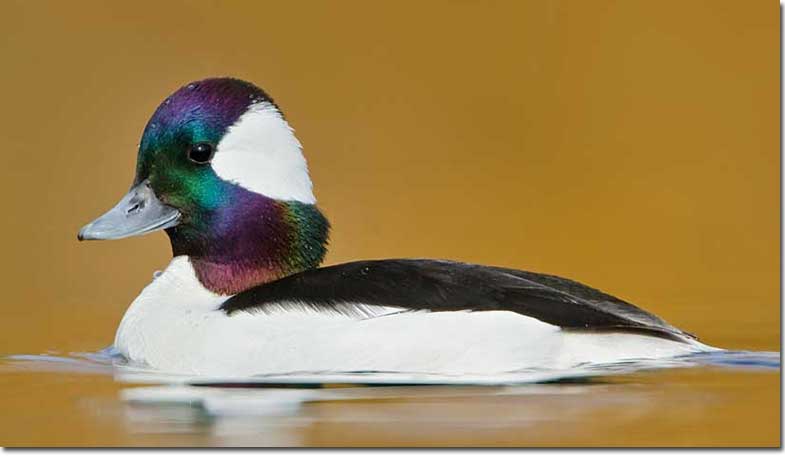
Buffleheads range across North America with their wintering range extending into Mexico. Males have a white body, a black back, and gray bills. The backside of their black heads has a large white patch. In good light, the dark part of their head will glimmer with purple-blue-green iridescence. Females are much more subdued. They have dark uppersides, dark gray bills, gray undersides and flanks, and black heads with a white patch on the cheek.
Frequently Asked Questions
How do you identify a Common Goldeneye?
A male Common Goldeneye can be identified by its striking black-and-white plumage, distinctive rounded white patches on its face, yellow eyes, and a noticeable iridescent green sheen on its head. Females are mottled gray with a brown head and yellow eyes.
What is the difference between a Common Goldeneye and a Barrows Goldeneye?
The key difference between male Common and Barrow’s Goldeneyes is the white patch on their face. In Common Goldeneyes it is small and round whereas in Barrow’s Goldeneyes it is larger and crescent-shaped. In females, it is the bill with Barrow’s having a yellowish bill with a black tip and Common Goldeneye females having a black bill with a yellowish tip.
What is the lifespan of a Common Goldeneye?
The expected lifespan of Common Goldeneyes is 11-12 years on average.
How big is a Common Goldeneye?
Common Goldeneyes are medium-sized ducks, measuring 16-20 inches long.
Is Goldeneye a diving duck?
Common Goldeneyes are diving ducks.

